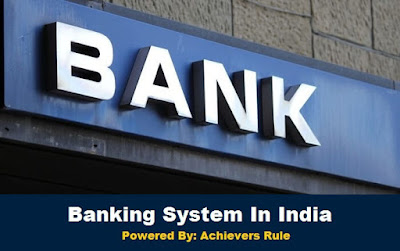
Overview of Indian Banking System
Special Key Points On Banking System in India- The 1st Bank established in India was- Bank of Hindustan in 1970 at Kolkata.
- Presidency Banks are: 1.Bank of Bengal in 1806, 2. Bank of Bombay in 1840, and 3. Bank of Madras in 1843.
- 1st bank of limited managed by Indians and founded in 1881 was – Oudh Commercial Bank.
- ‘Gift-Edged Securitas” means Securities issued by the Government.
- 1st Indian Bank was- Punjab National Bank, in 1891.
- Bank of India (1906, Mumbai) –was the 1st Indian bank opened its branch in Londoa (1946) outside of India.
- Fortune Global rank of SBI – 232.
- “Letter of Credit”- Letter by a bank to a person stating the terms and conditions of the loan sanctioned to him by the bank.
- “Demand Draft” is called a “Banker’s Cheque”.
- Long term loan provide to the farmer- Land Development Bank.
- “Dow Jones” – Share Market index of New York.
- Reserve Bank of India:
Reserve Bank of India - Important Key Points
RBI act pass in 1934 and
RBI established in 1935, 1st
Governor – Sir Osborn Smith.
|
On January In 1949 Reserve
Bank of India taken over by the Government and 1st Indian Government was
C.D.Deshmukh.
|
Major Activities of
RBI: 1. It regulates the currency and credit
system in India. 2. Foreign exchange reserves are kept by RBI. 3. It
maintains the exchange value of the Rupee. 4. One rupee note are not issue by
RBI. 5. RBI controls the finance system and Inflation with the activities of
“Open Market Operation “by Trade Bills. 6. RBI is responsible for the
collection and publication of monetary and financial information. 7. Acting
as an agent of Government in respect of India’s’ membership of the IMF.
|
The animal on the insignia of the RBI is Panther.
|
Quantitative credit control do not include RBI
directives.
|
- Bank Rate: it the rate at which the Reserve Bank of India gives credit to commercial banks.
- Statutory Liquid Ratio: it the Ratio by which the Banks are required to maintain a certain ratio between their cash in hand is total assets.
- Repo Rate: it is the Rate at which the banks lend to Reserve Bank of India.
14 Nationalised Banks (19 July in 1969) with their Headquarters:
Name of The Bank
|
HeadQuarters
|
Bank of
India
|
Mumbai
|
UCO Bank
|
Kolkata
|
Allahabad
Bank
|
Kolkata
|
Union Bank
of India
|
Mumbai
|
Bank of
Baroda
|
Vadodara
|
Indian
Overseas Bank
|
Chennai
|
Canara
Bank
|
Bangalore
|
Punjab
National Bank
|
New Delhi
|
Indian
Bank
|
Chennai
|
Syndicate
Bank
|
Manipal
|
Dena Bank
|
Mumbai
|
Central
Bank of India
|
Mumbai
|
United
Bank of India
|
Kolkata
|
Bank of
Maharashtra
|
Pune
|
Some Important Stock Exchange Institution and Year of Formation:
- Securities and Exchange Board of India – In 1988 (Mumbai).
- Over the counter exchange in India – in 1990 (Mumbai).
- National Stock Exchange – in 1992 (Mumbai).
- Bombay Stock Exchange - in 1875 (Mumbai) it was the oldest stock exchange in India.
- Ahmadabad Stock Exchange - 1894
- Calcutta Stock exchange – 1908.
Some Important Financial Institution:
- IFCI- Industrial Finance Corporation of India – in 1948-Activities: Medium and Long term loan provide for Industry development.
- ICICI – Industrial Credit and and Investment Corporation of India – in 1955(Mumbai) – Activities: it is a public sector and its main aim to development Small and Medium industry.
- SIDBI- Small Industries Development Bank of India – in 1989 (Lucknow) – Main aim to development small industries.
- IDBI Industrial Development Bank of India – in 1964(Mumbai) - 1st set up as a development organisation in 2004, 1st October its works as a General Business Bank and its name change from IDBI to IDBI ltd. It is the apex of Industrial Finance in India.
- NHB –National Housing Bank – in 1988 (New Delhi) – it is a part of RBI and provides Loan and economical activities for house establishment project.
- EXIM –Export-Import Bank of India – on 1st January, 1982 (Mumbai) – Provides economical support and development international business.
- NABARD – National Bank for Agriculture and Rural Development – in 1982(Mumbai) – Activities: Financing Rural Development.
6 Banks Nationalised on 15th April in 1980 with their Headquarters are given below:
Vijay Bank
|
Bangalore
|
Punjab and
Sind Bank
|
New Delhi
|
Corporation
Bank
|
Mangalore
|
New Bank
of India
|
Amritsar
|
Oriental
Bank of Commerce
|
New Delhi
|
Andhra
Bank
|
Hyderabad
|
- In 1993- New Bank of India and Punjab National Bank were merged.
- Now in India there have 27th Nationalised bank including Group of State Bank are given below:
- State Bank of Bikaner and Jaipur. State Bank of Hyderabad. State bank of India. State bank of Indore, State Bank of Travancore. State Bank of Mysore. State Bank of Patiala. State Bank of Sourastra.
- Bharatiya Mahila Bank – established by the merged of SBI-Indore in 2009 & Now It was Merged With STATE BANK OF INDIA in 2017.










Post a Comment